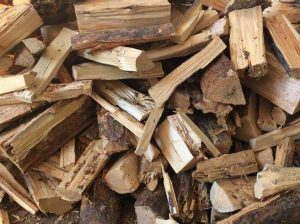Is Spruce Good for Firewood – Burning Questions About Spruce
Spruce trees grow fairly easily from zones 3 to 8. There are many different spruce varieties in the pinaceae family. Most large spruce varieties are harvested for paper and pulp production, but there are also spruces that are used for structural lumber. As a firewood option, spruce is not a great choice.

Heat Output and Efficiency (in BTUs)
Most spruce varieties only offer 16 million BTUs at the top end. If you live in Alaska and have access to Sitka spruce, you can get 21 million BTUs from a cord. Once seasoned, you’ll get a hot burn that will quickly drop to ash. Spruce can be a messy burn; you may notice a lot of soot and sparks when you burn spruce wood.
Creosote Buildup
Your risk of creosote build-up will be higher if you burn exclusively spruce. This wood does burn hot, but these trees produce a lot of sap. The risk of ash build-up inside your stove and fireplace will go up, as will the soot and ash inside your chimney.
If you don’t mind getting a bit dirty, it is possible to clean your own chimney of soot build-up. To start, put on some goggles and a mask. Working in the chimney can mean catching a lot of debris with your face. Open the damper and take a look up into the fireplace smoke chamber. If the surface is powdery and you can scrape away the build-up, a DIY brushing may be all your chimney needs.
However, if the walls of your chimney are shiny, you have creosote build-up that will need to be professionally removed. The sooner you get that build-up taken off, the safer you and your family will be. Burning creosote is incredibly dangerous. High levels of creosote build-up can damage your chimney liner. Spend the money to get your chimney checked, cleaned and capped before fire season.
Amount of Smoke, Spark and Coal Production
Properly seasoned spruce will produce a pleasant odor without generating a lot of smoke. However, this wood will always generate a lot of spark. The low BTU output of most spruce firewood and the tendency to burn quickly to ash can actually make these fires hard to tend. If you need to load up your woodstove for a cold night, too much spruce in the mix can leave you with a sparky fire that is hard to feed.
If you have a spot for outdoor fires, spruce can be a lovely choice. Timing is key when working with spruce. If you prefer to split your own lumber, try to split your spruce rounds in the winter. Wood with a high sap content will be more brittle in cold weather. Handling warm spruce will leave you a sticky mess.
Carefully check your cutting tools when working with any high-sap wood. A hot chain on a chainsaw covered with sap needs to cool down, be removed and be cleaned up with ammonia and a brush. Once dry, you’ll need to oil your chain and saw. If you notice sap build-up on your ax, start with rubbing alcohol to loosen up the sap and scrub it with a bit of baking soda. Dry and wax or oil your ax head.
How Long Will It Take to Season Spruce Firewood?
Spruce needs to season for at least 6 months and can take up to 2 years to fully cure. As you split your spruce firewood, do your best to stack it with plenty of airflow between the sticks. As summer comes on, this wood will be quite sticky to handle in the curing process.
Arrange your spruce in a sunny spot for drying. If you need to store firewood under a shed roof to keep it out of the rain, try to set it near the edge where it can catch the western sun. If you need to stack your firewood in ranks, make sure there is space for air to flow between the ranks. Never stack firewood so the ends touch the face of the stack beside it.
Is Spruce Firewood Expensive?
Depending on your region and your woodsman, spruce can be one of the cheaper woods that you purchase when shopping by the cord. Do be aware that spruce does serve other purposes. Paper production takes a great deal of spruce. There are also spruce trees that are a lucrative choice for Christmas trees. Finally, there are craftsman who use spruce lumber for custom construction, such as musical instruments.
If you have your own woodlot and have spruce trees you’re planning to harvest, you may be able to gain more financial benefit from selling your spruce to other users. Depending on the age and health of your trees, you can sell spruce for harvest and buy better firewood.
Because this firewood is prone to creating sparks, consider using this for firesticks early in the burn. Split it small to use low in your fire bank to light larger pieces of denser hardwoods that are not inclined to spark. If pieces of spruce firewood are high in your wood stack, the fire may be difficult to safely build up.
Pros and Cons of Using Spruce for Firewood
Pros:
- Spruce is quite beautiful in the landscape; if you’re thinning your own woodlot, you can plan your harvest to highlight the best trees
- Spruce firewood is quite easy to split
- Burning spruce creates a lovely fragrance. Some varieties of spruce are used for perfumes and air fresheners
Cons:
- The heat output for most spruce firewood is quite low
- This wood produces a very sparky fire; it may not be safe in an open fireplace
- The high sap level can make this firewood very tacky to handle
How Spruce Firewood Compares to Other Trees
Unlike box elder, the grain of your spruce firewood will split easily. Unlike alder, which also splits easily, this wood contains a lot of sap and can be sticky to handle. In addition to splitting well, this wood can be quite fibrous to cut. Like cottonwood, you can expect to be covered in chips when working with spruce. When possible, try to split and cut spruce in winter.
Unlike oak and box elder, spruce trees do not tend to drop a lot of branches in the heat. Depending on the variety, you may have to remove a lot of low branches to get to a good cutting surface. If the tree is large enough, you may be able to harvest the big branches for firewood and sell the main trunk to a craftsman for lumber.
As you work to put your spruce trees to use, make sure you also keep an eye out for other harvest options. There are folks who like to craft with the pine cones. Dropped needles may be coveted by local gardeners who want to increase the acidity of their soil for special plants. For example, if the soil in your region is basic, spruce needles can be put to good use by those trying to grow berries.
One of the nicest things about fully cured spruce is that the wood is both light to carry and pretty to look at. Most spruce wood has a very light yellow color when split and a fresh, clean scent.


